|
|
|
Sort Order |
|
|
|
Items / Page
|
|
|
|
|
|
|
| Srl | Item |
| 1 |
ID:
162362


|
|
|
| 2 |
ID:
160783
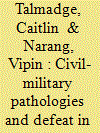

|
|
|
|
|
| Summary/Abstract |
This article uses an original data set, the Wartime Civil-military Relations Data Set, to test arguments about the causes of victory and defeat in war. Our analysis provides strong initial support for the notion that civil-military relations powerfully shape state prospects for victory and defeat. Specifically, states whose militaries have a significant internal role or whose regimes engage in coup-proofing appear to have a substantially lower probability of winning interstate wars, even when we account for the role of other important variables, including regime type and material capabilities. Crucially, our measures of civil-military relations include coup incidence but also move beyond it to detect more subtle indicators of civil-military relations. The resulting analysis should give us confidence in acknowledging the importance of nonmaterial variables in explaining war outcomes, while also paving the way for further research that can utilize and extend the data set.
|
|
|
|
|
|
|
|
|
|
|
|
|
|
|
|
| 3 |
ID:
083095


|
|
|
|
|
| Publication |
2008.
|
| Summary/Abstract |
How might Iran retaliate in the aftermath of a limited Israeli or U.S. strike? The most economically devastating of Iran's potential responses would be closure of the Strait of Hormuz. According to open-source order of battle data, as well as relevant analogies from military history and GIS maps, Iran does possess significant littoral warfare capabilities, including mines, antiship cruise missiles, and land-based air defense. If Iran were able to properly link these capabilities, it could halt or impede traffic in the Strait of Hormuz for a month or more. U.S. attempts to reopen the waterway likely would escalate rapidly into sustained, large-scale air and naval operations during which Iran could impose significant economic and military costs on the United States-even if Iranian operations were not successful in truly closing the strait. The aftermath of limited strikes on Iran would be complicated and costly, suggesting needed changes in U.S. force posture and energy policy.
|
|
|
|
|
|
|
|
|
|
|
|
|
|
|
|
| 4 |
ID:
076619
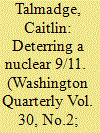

|
|
|
| 5 |
ID:
147905


|
|
|
|
|
| Summary/Abstract |
Why do some states generate competent, professional military organizations, while others fail to do so even when they have the required economic, demographic, and technological endowments? Variation in states’ military organizational practices—their core policies related to promotion patterns, training regimens, command arrangements, and information management—holds the key. This article develops a typology of such practices and explains why and how they vary in response to the internal and external threats facing particular regimes. The article then subjects this argument to a carefully designed plausibility probe comparing the threat environments and military organizational practices of two states whose differences are both intuitively and theoretically puzzling: North and South Vietnam during the period 1954–1975. The initial evidence provides support for the theory and casts doubt on existing explanations of military organizational behavior focused on external threats, democracy, or the degree of political intervention in the military. The findings have important implications for foreign policy, as well as for future research on authoritarianism, civil-military relations, and military effectiveness.
|
|
|
|
|
|
|
|
|
|
|
|
|
|
|
|
| 6 |
ID:
167672


|
|
|
|
|
| Summary/Abstract |
Recent commentary has sounded the alarm about the effects of emerging technologies on strategic stability, yet the topic has received relatively little systematic scholarly attention. Will emerging technologies such as cyber, autonomous weapons, additive manufacturing, hypersonic vehicles, and remote sensing make the world more dangerous? Or is pessimism unwarranted? In this volume, we leverage international relations scholarship, historical data, and a variety of methodological approaches to discern the future implications of new technologies for international security. The findings suggest that new technologies can have multiple, conditional, and even contradictory effects on different aspects of strategic stability, and raise a host of important questions for future research.
|
|
|
|
|
|
|
|
|
|
|
|
|
|
|
|
| 7 |
ID:
167678
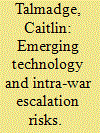

|
|
|
|
|
| Summary/Abstract |
Will emerging technologies increase the risk of conflict escalation? This paper develops a framework for evaluating the role of technology in different types of intra-war escalation. It then uses the framework to probe empirically the possible role of technology in escalation through three carefully chosen cases from Cold War. The findings largely cast doubt on the idea of emerging technologies as an independent, primary driver of otherwise avoidable escalation, suggesting instead that technology more likely functions as an intervening variable – a sometimes necessary, but rarely sufficient, condition for escalation. The conclusion explores the implications of this analysis for the future.
|
|
|
|
|
|
|
|
|
|
|
|
|
|
|
|
| 8 |
ID:
134007


|
|
|
|
|
| Publication |
2014.
|
| Summary/Abstract |
International relations theories emphasize the stabilizing role hegemons play in world politics. But little scholarship has examined the link connecting hegemony to its potentially positive returns in the security realm: force posture. We correct this deficit by developing and testing an argument about the consequences of different hegemonic force postures under varying threat conditions. We present a typology of force posture options and probe their effects through over-time analysis of how major powers have worked to provide one particularly important public good since 1945: access to Persian Gulf oil. Drawing on field work, we also explore the implications of our framework for current and future US force posture in the region. We conclude that hegemonic stability is a very real phenomenon in the Gulf, but it does not require the massive forward deployment of US forces that has characterized the past twenty years of US presence there.
|
|
|
|
|
|
|
|
|
|
|
|
|
|
|
|
| 9 |
ID:
142990


|
|
|
|
|
| Summary/Abstract |
Five years ago, the total number of U.S. military personnel in the Persian Gulf was over 230,000. Today, that number is well under 50,000. The rapid exit of so many U.S. fighting men and women has caused many observers to fear for the future of the Gulf. As one analyst put it, the regional forecast is bleak with “violence, followed by intermittent violence, and renewed violence.”
|
|
|
|
|
|
|
|
|
|
|
|
|
|
|
|
| 10 |
ID:
174619


|
|
|
|
|
| Summary/Abstract |
President Trump has routinely touted the foreign policy benefits of unpredictability. As candidate Trump complained about the US administration in 2016, “We are totally predictable. We tell everything. We’re sending troops? We tell them. We’re sending something else? We have a news conference.
|
|
|
|
|
|
|
|
|
|
|
|
|
|
|
|
| 11 |
ID:
121404


|
|
|
|
|
| Publication |
2013.
|
| Summary/Abstract |
Saddam's Iraq has become a cliché in the study of military effectiveness-the quintessentially coup-proofed, personalist dictatorship, unable to generate fighting power commensurate with its resources. But evidence from the later years of the Iran-Iraq War actually suggests that the Iraqi military could be quite effective on the battlefield. What explains this puzzling instance of effectiveness, which existing theories predict should not have occurred? Recently declassified documents and new histories of the war show that the Iraqi improvements stemmed from changes in Saddam's perceptions of the threat environment, which resulted in significant shifts in his policies with respect to promotions, training, command arrangements, and information management in the military. Threat perceptions and related changes in these practices also help explain Iraq's return to ineffectiveness after the war, as evident in 1991 and 2003. These findings, conceived as a theory development exercise, suggest that arguments linking regime type and coup-ridden civil-military relations to military performance need to take into account the threat perceptions that drive autocratic leaders' policies toward their militaries. After discussing how to define and measure battlefield effectiveness, the article reviews Saddam's changes and their effects; addresses alternative explanations for the improvement in Iraqi effectiveness; and explains how further research based on this initial exercise could generate a better understanding of the observed variation in states' battlefield effectiveness, including variation within and across autocratic regimes.
|
|
|
|
|
|
|
|
|
|
|
|
|
|
|
|
| 12 |
ID:
068700
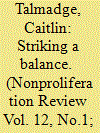

|
|
|
| 13 |
ID:
186756


|
|
|
|
|
| Summary/Abstract |
The military implications of Chinese control of Taiwan are understudied. Chinese control of Taiwan would likely improve the military balance in China's favor because of reunification's positive impact on Chinese submarine warfare and ocean surveillance capabilities. Basing Chinese submarine warfare assets on Taiwan would increase the vulnerability of U.S. surface forces to attack during a crisis, reduce the attrition rate of Chinese submarines during a war, and likely increase the number of submarine attack opportunities against U.S. surface combatants. Furthermore, placing hydrophone arrays off Taiwan's coasts for ocean surveillance would forge a critical missing link in China's kill chain for long-range attacks. This outcome could push the United States toward anti-satellite warfare that it might otherwise avoid, or it could force the U.S. Navy into narrower parts of the Philippine Sea. Finally, over the long term, if China were to develop a large fleet of truly quiet nuclear attack submarines and ballistic missile submarines, basing them on Taiwan would provide it with additional advantages. Specifically, such basing would enable China to both threaten Northeast Asian sea lanes of communication and strengthen its sea-based nuclear deterrent in ways that it is otherwise unlikely to be able to do. These findings have important implications for U.S. operational planning, policy, and grand strategy.
|
|
|
|
|
|
|
|
|
|
|
|
|
|
|
|
| 14 |
ID:
149473


|
|
|
|
|
| Summary/Abstract |
Coups remain a widespread and consequential political phenomenon, but it remains unclear whether interstate conflict protects leaders from the risk of coups or increases this risk. We theorize that interstate conflict—especially when it is prolonged—should protect domestic regimes from military overthrow by foreclosing many of the key pathways by which elites plot and execute coups. We test this argument using event history modeling. The evidence provides support for our claim that coup risk declines in the presence of enduring interstate conflict. Just as important, we detect no evidence that war increases coup risk.
|
|
|
|
|
|
|
|
|
|
|
|
|
|
|
|
| 15 |
ID:
152916
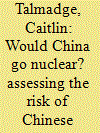

|
|
|
|
|
| Summary/Abstract |
Could a conventional war with the United States inadvertently prompt Chinese nuclear escalation? The military-technical threat that such a war would pose to China's retaliatory capability—combined with wartime perceptual dynamics that might cause China to view this threat in an especially pessimistic light—could lead to reasonable Chinese fears that the United States might be attempting conventional counterforce, or considering or preparing for nuclear counterforce. China might see several forms of limited nuclear escalation as its least-bad response to this sort of threat to its nuclear deterrent, notwithstanding the country's no-first-use policy. This finding, derived from a more general framework about the military-technical and perceptual drivers of potential nuclear escalation in response to conventional counterforce, has broader ramifications for U.S. policy and military strategy, and it illustrates recurring dilemmas that the United States may face in conventional wars with other nuclear-armed adversaries.
|
|
|
|
|
|
|
|
|
|
|
|
|
|
|
|
|
|
|
|
|